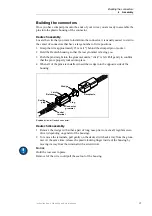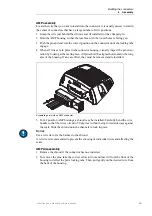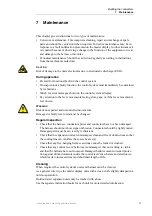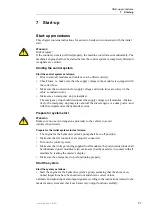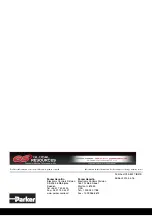
7
Connectors
4 Mounting
Instruction book, Mounting and maintenance
4
Mounting
For mounting instructions for the respective modules, see the installation sheet that is
packed with the unit upon delivery. See also the separate instruction books for each
unit.
W
ARNING
Risk of unexpected and uncontrolled movements.
An incorrectly located or mounted harness can be affected by radio signals which can
interfere with the system’s functions.
Locating the harness
N
OTICE
Install the harness per the following guidelines:
•
Protect the harness against radio signals which can interfere with the system's func-
tions. Avoid putting the control system's harness close to communications equip-
ment, antennas, generators or other high-frequency electrical interference sources.
Note that antenna cables can also interfere with the system. Separate the cabling
from the antenna cable.
•
Separate the control system's current supply from the communication equipment's
current supply.
•
Locate the harness so that, as much as possible, it is shielded by sheet metal with
good electrical connection to the battery's negative terminal. Place the harness in
beams or channels enclosed by sheet. If this is not possible, locate the harness in the
in-most corner of the channel. If there are no beams or channels, locate the harness
towards sheet metal surfaces.
•
Protect the harness against mechanical wear.
•
Avoid free-hanging cables. Free-hanging cables must be placed so there is no risk
that it can be folded or crushed.
•
When the harness passes sharp edges, the harness must be protected with an edge
list or lead-in wire. An opening through a bulkhead is an example of an edge.
Attaching the harness
N
OTICE
Fix the harness to the machine per the following guidelines:
•
Use a conduit or loom to hold the wires/cables together.
•
Fix the harness with binding tape, clips, glue or another type of fastener. The dis-
tance between the fastening points must be adapted so that the harness is free from
vibrations to the frame.
•
When movement is required, the length of the cabling is adapted so that a bend is
formed. The radius should be as big as possible. The cabling must not be in danger
of being fully stretched. The radius in the bend of the cabling must not be less than
the is recommended by the manufacturer, (e.g.20 times the diameter of the cabling).

















